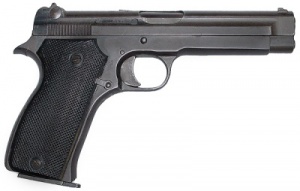Pistolet automatique mle 1935S

| |
| Pistolet Automatique modèle 1935S | |
| Specifications | |
| Type | Single-Shot Anti-Tank Rifle |
| Caliber | 7.65mm |
| Feed System | 8 Round Clip |
| Muzzle Velocity | 345m/s |
| Maximum Effective Range | 35m |
History
Charles Petter, a Swiss national invalided out of the French Foreign Legion after suffering severe wounds in North Africa, joined the Societé Alsacienne de Construction Mécanique (SACM) at Cholet, Alsace in the early 1930s as an engineer. He eventually took charge of the firearms department. In 1934, he patented a pistol design: a locked-breech weapon in which the slide and barrel were locked together by lugs and unlocked after a short recoil stroke.
Petter had engineered the locking mechanism into a removable module similar to one in the Russian Tokarev pistol but as the Tokarev was entirely unknown outside of the Soviet military at that time, it seems probable that Petter developed his design independently. The prototype was submitted to the French Army, which put it through trials and adopted it as the Pistolet automatique modèle 1935 (Automatic Pistol Model 1935; abbreviated PA mle 1935). The pistol became the official French service sidearm in 1936 but did not enter large-scale production until 1938.
Manufacture d’Armes de St. Etienne (MAS) assumed most of the responsibility for supplying the automatic pistol and produced it as the MAS 1935. MAS engineers reworked the design in 1937 to simplify production, after which the original model was known as the PA mle 1935A and the new, simplified model became the PA mle 1935S. The differences in the two versions are immediately apparent to anyone holding them. The mle 1935A is much smoother, with a butt shaped to fit the hand and an excellent finish. The mle 1935S is a more angular and more poorly finished weapon that was, nevertheless, equally serviceable.
The mle 1935 chambered a 7.65mm longue (long) cartridge, actually a direct copy of the US .30 Pedersen round. The French military had selected this ammunition type for pistols and submachine guns (such as the PM MAS mle 38) for it had comparable accuracy and penetration capability to the 9mm Parabellum round while being 30% lighter. But the 7.65mm longue round lacked stopping power, and proved only marginally effective as a combat round. Other than the ammunition, the pistol was a solid design, with an action similar to the Colt M1911.
In 1937, Switzerland’s Schweizer Industrial Gesellschaft Co. (SIG) purchased a licence from SACM to exploit and develop the Petter patents, from which it subsequently developed the SIG pistols. After World War II, the French design, reworked to chamber a 9mm cartridge, was re-issued as the MAS 1950 pistol.